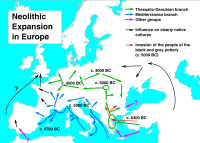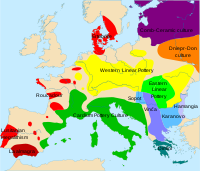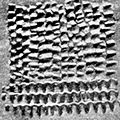Cardium pottery
 | |
| Geographical range | Middle East, North Africa, Southern Europe |
|---|---|
| Period | Neolithic Europe |
| Dates | c. 6400 BC – c. 5500 BC |
| Major sites | Liguria, Sardinia, Coppa Nevigata |
| Preceded by | Paleolithic Europe |
| Followed by | Kakanj culture |
| Preceded by the Pleistocene |
| Holocene Epoch |
|---|
|
ICS stages/ages (official)
|
|
Blytt–Sernander stages/ages
*Relative to year 2000 (b2k). †Relative to year 1950 (BP/Before "Present"). |



Cardium pottery or Cardial ware is a Neolithic decorative style that gets its name from the imprinting of the clay with the heart-shaped shell of the Corculum cardissa , a member of the cockle family Cardiidae. These forms of pottery are in turn used to define the Neolithic culture which produced and spread them, commonly called the "Cardial culture".
The alternative name, impressed ware, is given by some archaeologists to define this culture, because impressions can be made with sharp objects other than cockle shells, such as a nail or comb.[1] Impressed pottery is much more widespread than the Cardial.[2] Impressed ware is found in the zone "covering Italy to the Ligurian coast" as distinct from the more western Cardial extending from Provence to western Portugal. The sequence in prehistoric Europe has traditionally been supposed to start with widespread Cardial ware, and then to develop other methods of impression locally, termed "epi-Cardial". However the widespread Cardial and Impressed pattern types overlap and are now considered more likely to be contemporary.[3]
The Mediterranean Neolithic[]
This pottery style gives its name to the main culture of the Mediterranean Neolithic: Cardium pottery culture or Cardial culture, or impressed ware culture, which eventually extended from the Adriatic sea to the Atlantic coasts of Portugal and south to Morocco.[4]
The earliest impressed ware sites, dating to 6400–6200 BC, are in Epirus and Corfu. Settlements then appear in Albania and Dalmatia on the eastern Adriatic coast dating to between 6100 and 5900 BC.[5] The earliest date in Italy comes from Coppa Nevigata on the Adriatic coast of southern Italy, perhaps as early as 6000 cal B.C. Also during Su Carroppu culture in Sardinia, already in its early stages (low strata into Su Coloru cave, c. 6000 BC) early examples of cardial pottery appear.[6] Northward and westward all secure radiocarbon dates are identical to those for Iberia c. 5500 cal BC, which indicates a rapid spread of Cardial and related cultures: 2,000 km from the gulf of Genoa to the estuary of the Mondego in probably no more than 100–200 years. This suggests a seafaring expansion by planting colonies along the coast.[7]
Older Neolithic cultures existed already at this time in eastern Greece and Crete, apparently having arrived from the Levant, but they appear distinct from the Cardial or impressed ware culture. The ceramic tradition in the central Balkans also remained distinct from that along the Adriatic coastline in both style and manufacturing techniques for almost 1,000 years from the 6th millennium BC.[8] Early Neolithic impressed pottery is found in the Levant, and certain parts of Anatolia, including , and in North Africa at , Tunisia. So the first Cardial settlers in the Adriatic may have come directly from the Levant. Of course it might equally well have come directly from North Africa, and impressed pottery also appears in Egypt. Along the East Mediterranean coast impressed ware has been found in North Syria, Palestine and Lebanon.[9]
Cardial and Epicardial fossils that were analysed for ancient DNA were found to carry the rare mtDNA (maternal) basal haplogroup N*, supporting an early Neolithic maritime colonization of Mainland Europe through Cyprus and the Aegean Islands by Near-Eastern farmers.[10]
Gallery[]
Genetics[]
Fernández et al. 2014 found traces of maternal genetic affinity between people of the Linear Pottery Culture and Cardium pottery with earlier peoples of the Near Eastern Pre-Pottery Neolithic B, and suggested that Neolithic period was initiated by seafaring colonists from the Near East.[11]
Olalde et al. 2015 examined the remains of 6 Cardials buried in Spain c. 5470-5220 BC. The 6 samples of mtDNA extracted belonged to the maternal haplogroups K1a2a, X2c, H4a1a (2 samples), H3 and K1a4a1.[12] The authors of the study suggested that the Cardials and peoples of the Linear Pottery Culture were descended from a common farming population in the Balkans, which had subsequently migrated further westwards into Europe along the Mediterranean coast and Danube river respectively.[13] Among modern populations, the Cardials were found to be most closely related to Sardinians and Basque people.[14] The Iberian Cardials carried a noticeable amount of hunter-gatherer ancestry. This hunter-gatherer ancestry was more similar to that of Eastern Hunter-Gatherers (EHGs) than Iberian hunter-gatherers, and appeared to have been acquired before the Cardial expansion into Iberia.[15]
Mathieson et al. 2018 examined three Cardials buried at the Zemunica Cave in modern-day Croatia c. 5800 BC.[16] The two samples of Y-DNA extracted belonged to the paternal haplogroups C1a2 and E1b1b1a1b1, while the three samples of mtDNA extracted belonged to the maternal haplogroups H1, K1b1a and N1a1.[17] The team further examined two Cardials buried at Kargadur in modern-day Croatia c. 5600 BC.[18] The one male carried the paternal haplogroup G2a2a1, and the maternal haplogroup H7c, the female carried H5a..[18] All three belonged to the Early European Farmer (EEF) cluster, thus being closely related to earlier Neolithic populations of north-west Anatolia, of the Balkan Neolithic, contemporary peoples of the Central European Linear Pottery culture, and later peoples of the Cardial Ware culture in Iberia. This would suggest that the Cardial Ware people and the Linear Pottery people were derived from a single migration from Anatolia into the Balkans, which then split into two and expanded northward and westward further into Europe.[19]
See also[]
- Byblos
- Prehistoric Iberia
- Prehistoric Italy
- Prehistory of Corsica
References[]
- ^ "Impressed Ware Culture". The Concise Oxford Dictionary of Archaeology. Retrieved 11 May 2008.
- ^ "Impressed Ware". The Concise Oxford Dictionary of Archaeology. Retrieved 11 May 2008.
- ^ William K. Barnett, Cardial pottery and the agricultural transition, in Douglas T Price (ed.), Europe's First Farmers (2000), p. 96.
- ^ Antonio Gilman, Neolithic of Northwest Africa, Antiquity, vol 48, no. 192 (1974), pp 273–282.
- ^ Barry Cunliffe, Europe Between the Oceans (2008), pp.115–6; Staso Forenbaher and Preston Miracle, The spread of farming in the Eastern Adriatic, Antiquity, vol. 79, no. 305 (September 2005), additional tables.
- ^ Showcase 3 in the Archeological Museum G. A. Sanna in Sassari
- ^ Zilhão (2001). "Radiocarbon evidence for maritime pioneer colonization at the origins of farming in west Mediterranean Europe". PNAS. 98 (24): 14180–14185. Bibcode:2001PNAS...9814180Z. doi:10.1073/pnas.241522898. PMC 61188. PMID 11707599.
- ^ Michela Spataro, Cultural diversities: The Early Neolithic in the Adriatic region and the Central Balkans: a pottery perspective, chapter 3 in Dragos Gheorghiu (ed.), Early Farmers, Late Foragers, and Ceramic Traditions: On the Beginning of Pottery in the Near East and Europe (2009).
- ^ Emre Guldogan, Mezraa-Teleilat settlement impressed ware and transferring Neolithic life style?, in Paolo Matthiae et al. (eds.), Proceedings of the 6th International Congress of the Archaeology, vol. 3 (2010), pp. 375–380.
- ^ Fernández, Eva; et al. (2014). "Ancient DNA analysis of 8000 BC near eastern farmers supports an early neolithic pioneer maritime colonization of Mainland Europe through Cyprus and the Aegean Islands". PLOS Genetics. 10 (6): e1004401. doi:10.1371/journal.pgen.1004401. PMC 4046922. PMID 24901650.
- ^ Fernández et al. 2014, p. 1.
- ^ Olalde et al. 2015, p. 2, Table 1.
- ^ Olalde et al. 2015, pp. 4–5.
- ^ Olalde et al. 2015, p. 4.
- ^ Olalde et al. 2015, pp. 1, 4–5.
- ^ Mathieson et al. 2018, Supplementary Information, p. 21.
- ^ Mathieson et al. 2018, Supplementary Table 1, Rows 104-106.
- ^ Mathieson et al. 2018, Supplementary Table 1, Rows 95-96.
- ^ Mathieson et al. 2018, pp. 4–5. "We confirm that Mediterranean populations, represented in our study by individuals associated with the Epicardial Early Neolithic from Iberia, are closely related to Danubian populations represented by the Linearbandkeramik (LBK) from central Europe, and that both are closely related to the Balkan Neolithic population. These three populations form a clade with the NW Anatolian Neolithic individuals as an outgroup, consistent with a single migration into the Balkan peninsula, which then split into two.
Sources[]
- Mathieson, Iain; et al. (21 February 2018). "The genomic history of southeastern Europe". Nature. Nature Research. 555 (7695): 197–203. Bibcode:2018Natur.555..197M. doi:10.1038/nature25778. PMC 6091220. PMID 29466330.
- Olalde, Iñigo; et al. (2 September 2015). "A Common Genetic Origin for Early Farmers from Mediterranean Cardial and Central European LBK Cultures". PLOS Genetics. PLOS. 32 (12): 3132–3142. doi:10.1093/molbev/msv181. PMC 4652622. PMID 26337550.
- Fernández, Eva; et al. (5 June 2014). "Ancient DNA Analysis of 8000 B.C. Near Eastern Farmers Supports an Early Neolithic Pioneer Maritime Colonization of Mainland Europe through Cyprus and the Aegean Islands". PLOS Genetics. PLOS. 10 (6): e1004401. doi:10.1371/journal.pgen.1004401. PMC 4046922. PMID 24901650.
Further reading[]
- Shennan, Stephen (2018). The First Farmers of Europe: An Evolutionary Perspective. Cambridge World Archaeology. Cambridge University Press. doi:10.1017/9781108386029. ISBN 9781108422925.
External links[]
| Wikimedia Commons has media related to Cardial pottery. |
- History of the Mediterranean
- Neolithic Thessaly
- Types of pottery decoration
- Archaeological cultures of Southeastern Europe
- Archaeological cultures of Southern Europe
- Archaeological cultures of Southwestern Europe
- Neolithic cultures of Europe
- Neolithic cultures of Africa
- Archaeological cultures in Albania
- Archaeological cultures in Croatia
- Archaeological cultures in France
- Archaeological cultures in Greece
- Archaeological cultures in Italy
- Archaeological cultures in Morocco
- Archaeological cultures in Portugal
- Archaeological cultures in Spain






